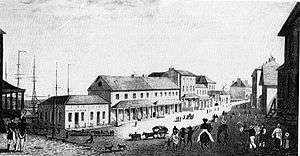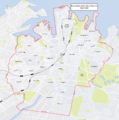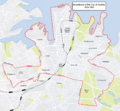City of Sydney
| City of Sydney New South Wales | |||||||||||||
|---|---|---|---|---|---|---|---|---|---|---|---|---|---|
 Location in Metropolitan Sydney | |||||||||||||
 | |||||||||||||
| Population | 205,339 (2015)[1] (18th) | ||||||||||||
| • Density | 8,213.56/km2 (21,273.0/sq mi) | ||||||||||||
| Established | 20 July 1842 | ||||||||||||
| Area | 25 km2 (9.7 sq mi) | ||||||||||||
| Time zone | AEST (UTC+10) | ||||||||||||
| • Summer (DST) | AEDT (UTC+11) | ||||||||||||
| Lord Mayor | Clover Moore (Independent) | ||||||||||||
| Council seat | Sydney CBD (Town Hall) | ||||||||||||
| Region | Metropolitan Sydney | ||||||||||||
| State electorate(s) | |||||||||||||
| Federal Division(s) | |||||||||||||
|
| |||||||||||||
| Website | City of Sydney | ||||||||||||
| |||||||||||||
The City of Sydney is the local government area covering the Sydney central business district and surrounding inner city suburbs of the greater metropolitan area of Sydney, New South Wales, Australia.
The central business district of Sydney is roughly bounded by Circular Quay and Sydney Harbour to the north, Macquarie Street to the east, Darling Harbour to the west and Liverpool Street and Central railway station to the south.
On 6 February 2004, the former local government area of the City of South Sydney was formally merged into the City of Sydney. Suburbs within the boundaries of the City of Sydney before the merger include the central business district of Sydney itself, Pyrmont and Ultimo to the west, Haymarket to the south, and other suburbs. Suburbs within the City of South Sydney before the merger included Woolloomooloo, Alexandria, Darlington (now mostly occupied by the University of Sydney), Erskineville, Newtown, Redfern, Glebe, Waterloo, most of Surry Hills and a portion of Paddington.
The leader of the City of Sydney holds the title of the Lord Mayor of Sydney. The current Lord Mayor is Councillor Clover Moore who has been in office since 27 March 2004.
Suburbs and localities in the local government area
Suburbs within or partially within the City of Sydney are:
- Alexandria
- Annandale (shared with Inner West Council)
- Barangaroo
- Beaconsfield
- Camperdown (shared with Inner West Council)
- Centennial Park
- Chippendale
- Darlinghurst
- Darlington
- Dawes Point
- Elizabeth Bay
- Erskineville
- Eveleigh
- Forest Lodge
- Glebe
- Haymarket
- Millers Point
- Moore Park
- Newtown (shared with Inner West Council)
- Paddington (shared with Municipality of Woollahra)
- Potts Point
- Pyrmont
- Redfern
- Rosebery (shared with Bayside Council)
- Rushcutters Bay
- Surry Hills
- Sydney CBD
- The Rocks
- Ultimo
- Waterloo
- Woolloomooloo
- Zetland
Localities in the City of Sydney are:
Demographics
At the 2011 Census, there were 169,505 people in the Sydney local government area, of these 52.8% were male and 47.2% were female. Aboriginal and Torres Strait Islander people made up 1.3% of the population. The median age of people in the City of Sydney was 32 years. Children aged 0 – 14 years made up 7.1% of the population and people aged 65 years and over made up 7.9% of the population. Of people in the area aged 15 years and over, 25.5% were married and 10.1% were either divorced or separated.[2]
Population growth in the City of Sydney between the 2001 Census and the 2006 Census was 3.31%; and in the subsequent five years to the 2011 Census, population growth was 4.57%. When compared with total population growth of Australia for the same periods, being 5.78% and 8.32% respectively, population growth in the Sydney local government area was a little over half the national average.[3] The median weekly income for residents within the City of Sydney was more than 1.5 times the national average.[2][4]
The proportion of dwellings in the City of Sydney that are apartments or units is 73.6%, which is substantially different from the Australian average of 13.6%. The proportion of residents in the Sydney local government area that claimed Australian ancestry was approximately half the national average.[2]
| Selected historical census data for Sydney local government area | ||||||
|---|---|---|---|---|---|---|
| Census year | 1996[5] a | 2001[3][6] | 2006[4] | 2011[2] | ||
| Population | Estimated residents on Census night | 87,874 | 124,512 | 156,571 | 169,505 | |
| LGA rank in terms of size within New South Wales | 10th | |||||
| % of New South Wales population | 0.92% | |||||
| % of Australian population | 0.49% | |||||
| Cultural and language diversity | ||||||
| Ancestry, top responses | English | 19.3% | ||||
| Australian | 13.9% | |||||
| Chinese | 9.7% | |||||
| Irish | 8.5% | |||||
| Scottish | 5.8% | |||||
| Language, top responses (other than English) | Mandarin | 3.7% | ||||
| Cantonese | 3.3% | |||||
| Thai | n/c | |||||
| Indonesian | 1.7% | |||||
| Korean | 1.6% | |||||
| Religious affiliation | ||||||
| Religious affiliation, top responses | No religion | 26.7% | ||||
| Catholic | 23.6% | |||||
| Anglican | 14.7% | |||||
| Buddhism | 2.9% | |||||
| Eastern Orthodox | 3.9% | |||||
| Median weekly incomes | ||||||
| Personal income | Median weekly personal income | A$717 | A$888 | |||
| % of Australian median income | 153.9% | 153.9% | ||||
| Family income | Median weekly family income | A$1,204 | A$2,273 | |||
| % of Australian median income | 117.2% | 153.5% | ||||
| Household income | Median weekly household income | A$1,819 | A$1,639 | |||
| % of Australian median income | 105.9% | 132.8% | ||||
- ^a 1996 Census figures refer to the City of Sydney prior to its merger with the City of South Sydney.
Politics

As noted above, the electoral boundary of the City of Sydney have been significantly altered by state governments on at least four occasions since 1945, with advantageous effect to the governing party in the New South Wales Parliament at the time. Successive State governments of both major parties, Labor and Liberal, have re-drawn the electoral boundaries to include inner suburbs that are traditionally supportive of them, and to exclude suburbs that are traditionally hostile. In 1972 the Council had prepared the City of Sydney Strategic Plan, only the second city (after New York) to prepare a comprehensive assessment and plan of major issues for the future. With triennial reviews, this guided development of the City for twenty years,[7] and a similar planning process has continued.
A 1987 Liberal re-organisation saw Sydney Council split, with southern suburbs forming a new South Sydney Council. This was thought to advantage the Liberal government of the day, as the southern suburbs had traditionally voted Labor.
In 2004, the Labor State Government undid this change, again merging the councils of the City of Sydney and the South Sydney Council. Critics claimed that this was performed with the intention of creating a "super-council" which would be under the control of Labor, which also controlled the State Government. Subsequent to this merger, an election took place on 27 March 2004 which resulted in the independent candidate Clover Moore defeating the high-profile Labor candidate, former federal minister Michael Lee and winning the position of Lord Mayor. Critics of the merger claimed that this was a result of a voter backlash against the party for attempting to create the "super-council".
The daily administration of the City of Sydney is performed by its General Manager, currently Monica Barone, who reports to the Council.
Current composition and election method
Sydney City Council is composed of ten Councillors, including the Lord Mayor, for a fixed four-year term of office. The Lord Mayor is directly elected while the nine other Councillors are elected proportionally. The most recent election was held on 10 September 2016, and the makeup of the Council, including the Lord Mayor, is as follows:[8]
| Party | Councillors | |
|---|---|---|
| Clover Moore Independent Team | 6 | |
| Liberal Party of Australia | 2 | |
| Australian Labor Party | 1 | |
| Sydney Matters Independent Team | 1 | |
| Total | 10 | |
The current Council, elected in 2016, in order of election, is:[8]
| Councillor | Party | Notes | |
|---|---|---|---|
| Clover Moore | Clover Moore Independents | Lord Mayor | |
| Kerryn Phelps | Clover Moore Independents | Deputy Lord Mayor | |
| Christine Forster | Liberal | ||
| Linda Scott | Labor | ||
| Philip Thalis | Clover Moore Independents | ||
| Jess Scully | Clover Moore Independents | ||
| Robert Kok | Clover Moore Independents | ||
| Jess Miller | Clover Moore Independents | ||
| Craig Chung | Liberal | ||
| Angela Vithoulkas | Sydney Matters | ||
History

The name Sydney comes from "Sydney Cove" which is where the English admiral Arthur Phillip established the first settlement, after arriving with the First Fleet. On 26 January 1788, he named it after Thomas Townshend, 1st Viscount Sydney, who was the home secretary at the time, and the man responsible for the plan for the convict colony in Australia.
The "City of Sydney" was established on 20 July 1842[9] by the Corporation Act which encompasses present-day Woolloomooloo, Surry Hills, Chippendale and Pyrmont, an area of 11.65 km². There were six wards established by boundary posts. A boundary post still exists in front of Sydney Square.
The boundaries of the City of Sydney have changed fairly regularly since 1900. The bankrupt Municipality of Camperdown was merged with the city in 1909. As a result of the Local Government (Areas) Act 1948, the municipalities of Alexandria, Darlington, Erskineville, Newtown, Redfern, The Glebe, Waterloo, and Paddington were added to the City. In 1968 the boundaries were changed and many of these suburbs moved to be part of a new municipality of South Sydney. South Sydney was brought back into the city in 1982, but became separate again under the City of Sydney Act of 1988 and then became smaller than its original size at 6.19 km². It grew again in February 2004 with the merger of the two council areas, and now has a population of approximately 170,000 people.
Boundary changes
-

Boundaries pre 1909
-

Boundaries 1909-1949
-

Boundaries 1949-1968
-

Boundaries 1968-1982
-

Boundaries 1982-1988
-

Boundaries 1989-2003
Policies and initiatives
Environment
The City of Sydney has adopted various strategies and practises as climate change has become a major issue in Australia. Alarmingly, Australia's greenhouse gas emissions are some of the highest in the world per capita which has prompted a high level of concern. Thus, strategies have been implemented by the City of Sydney since the 2000s to reduce car pollution by encouraging mass and public transit[10] and introducing a fleet of 10 new Nissan LEAF electric cars, the largest order of the pollution-free vehicle in Australia.[11] Electric cars do not produce carbon monoxide and nitrous oxide, gases which contribute to climate change.[12][13] Cycling trips have increased by 113% across Sydney's inner-city since March 2010, with approximately 2,000 bikes passing through top peak-hour intersections on an average weekday.[14]
The City of Sydney became the first council in Australia to achieve formal certification as carbon-neutral in 2008.[15][16] The city has reduced its 2007 carbon emissions by 6% and since 2006 has reduced carbon emissions from city buildings by up to 20%.[14][17] The City of Sydney introduced a Sustainable Sydney 2030 program, with various targets planned and a comprehensive guide on how to reduce energy in homes and offices within Sydney by 30%.[14][18] Reductions in energy consumption have slashed energy bills by $30 million a year.[19] Solar panels have been established on many CBD buildings in an effort to minimise carbon pollution by around 3,000 tonnes a year.[20] Sydney has also become a leader in the development of green office buildings and enforcing the requirement of all building proposals to be energy-efficient.
The One Central Park development, completed in 2013, is an example of this implementation and design.[21][22][23][24] Proposals to make all of Sydney's future buildings sustainable and environmentally friendly by using recycled water, rooftop gardens, efficient and renewable energy.
Sydney Peace Prize
The City of Sydney is a major supporter of the Sydney Peace Prize.
Sister cities
Sydney City Council maintains sister city relations with the following cities:[25]
 San Francisco, California, United States, since 1968
San Francisco, California, United States, since 1968 Nagoya, Japan, since 1980
Nagoya, Japan, since 1980 Wellington, New Zealand, since 1982
Wellington, New Zealand, since 1982 Portsmouth, England, United Kingdom, since 1984
Portsmouth, England, United Kingdom, since 1984 Guangzhou, China, since 1985
Guangzhou, China, since 1985 Florence, Tuscany, Italy, since 1986
Florence, Tuscany, Italy, since 1986
Friendship Cities
 Paris, France, since 1998
Paris, France, since 1998 Berlin, Germany, since 2000
Berlin, Germany, since 2000 Athens, Greece, since 2000
Athens, Greece, since 2000 Dublin, Ireland, since 2002
Dublin, Ireland, since 2002
Economy
The City of Sydney contains Sydney's central business district. This includes a prominent financial hub surrounding Martin Place. Over 600,000 people travel into the City of Sydney each day for work or sightseeing. Along with North Sydney, Parramatta, Maquarie Park, Chatswood, Blacktown, Liverpool and Bankstown, it is one of the major CBDs that exists within the Sydney Metropolitan area.[26] Notable companies that is based in Sydney includes: APN News and Media, Fairfax Media, Westpac and Woolworth Limited.
See also
References
- ↑ "3218.0 – Regional Population Growth, Australia, 2014–15". Australian Bureau of Statistics. Retrieved 29 September 2016.
- 1 2 3 4 Australian Bureau of Statistics (31 October 2012). "Sydney (C)". 2011 Census QuickStats. Retrieved 22 October 2012.
- 1 2 Australian Bureau of Statistics (9 March 2006). "Sydney (C)". 2001 Census QuickStats. Retrieved 11 November 2012.
- 1 2 Australian Bureau of Statistics (25 October 2007). "Sydney (C)". 2006 Census QuickStats. Retrieved 11 November 2012.
- ↑ 2006 "Sydney (C)" Check
|url=value (help). Religious Affiliation by Age - Time Series Statistics (1996, 2001, 2006 Census Years). Australian Bureau of Statistics. 27 June 2007. Retrieved 12 November 2012. - ↑ Australian Bureau of Statistics (9 March 2006). "South Sydney (C)". 2001 Census QuickStats. Retrieved 11 November 2012.
- ↑ See, for example, City of Sydney Strategic Plan, 1980
- 1 2 "Sydney City Council". Local Government Elections 2016. Electoral Commission of New South Wales. 10 September 2016. Retrieved 22 September 2012.
- ↑ "History of Sydney City Council" (PDF). City of Sydney. Archived from the original (PDF) on 3 December 2012. Retrieved 9 February 2007.
- ↑ "Buses and the Environment". statetransit.info. Retrieved 3 February 2015.
- ↑ "City clears the way on pollution-free car fleet". sydneymedia.com.au. 13 February 2013. Retrieved 3 February 2015.
- ↑ "Causes of Climate Change". epa.gov. Retrieved 10 February 2015.
- ↑ IPCC, "Summary for Policymakers", Detection and Attribution of Climate Change,
«It is extremely likely that human influence has been the dominant cause of the observed warming since the mid-20th century» (page 15) and «In this Summary for Policymakers, the following terms have been used to indicate the assessed likelihood of an outcome or a result: (...) extremely likely: 95–100%» (page 2).
, in IPCC AR5 WG1 2013. - 1 2 3 "Achievements – City of Sydney". cityofsydney.nsw.gov.au. Retrieved 3 February 2015.
- ↑ "Sydney Water to become carbon neutral". The Age. 19 July 2007. Retrieved 3 February 2015.
- ↑ "Sydney Becomes Australia's First Carbon-Neutral Government Body". treehugger.com. 5 September 2008. Retrieved 3 February 2015.
- ↑ "It's official: Sydney is first carbon-neutral council". SydneyMedia.com.au. 9 November 2011. Retrieved 3 February 2015.
- ↑ "Building owners applaud city's ambitious master plan". climatecontrolnews.com.au. 25 February 2015. Retrieved 18 March 2015.
- ↑ "Sydney businesses cotton on: climate change action is good for the bottom line". The Guardian (UK). 18 March 2015. Retrieved 19 March 2015.
- ↑ "City of Sydney extends solar roll out to historic Rocks". RenewEconomy.com. 16 June 2014. Retrieved 3 February 2015.
- ↑ "'Greenest' Sydney building using rainforest timber". Sydney Morning Herald. 27 July 2011. Retrieved 3 February 2015.
- ↑ "One Central Park Gardens". Frasers Property. Archived from the original on 23 September 2013. Retrieved 3 February 2015.
- ↑ "Central Park Sydney – Architecture". Frasers Property. Archived from the original on 5 October 2013. Retrieved 3 February 2015.
- ↑ "Sydney Central Park project shows sustainable living". Financial Review. 28 November 2013. Retrieved 3 February 2015.
- ↑ City of Sydney: Sister City
- ↑ "Sydney's newest CBDs are the place to be :Allam Property Group". allam.com.au. Retrieved 2016-04-08.
External links
- Official website for the City of Sydney
- Official tourism site for the City of Sydney
-
 City of Sydney travel guide from Wikivoyage
City of Sydney travel guide from Wikivoyage - A Photographer's Guide to Sydney Skyline
- Sustainability & Life Resilience Overview for Sydney
Coordinates: 33°52′S 151°12′E / 33.867°S 151.200°E
